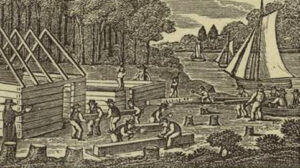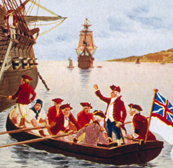
Credit: The New York Public Library, Mid-Manhattan Library Picture collection; published 1876
For a brief period during the 16th century, Virginia was the only English colony in North America. The first settlement was established in 1587 on Roanoke Island, in what is now North Carolina. By the 1600s, the Virginia colony comprised the entire coast of North America, including the shoreline of Acadia, and a vast area of inland Canada. In 1607, settlements were established at Jamestown and at the Popham colony, but only Jamestown survived. By 1620, the portion of Virginia north of the 39th parallel became New England. Despite the emergence of other English colonies in North America, the Virginia colony was by far the most influential in the 17th and 18th centuries in defining the country’s social and cultural character leading up to the Revolutionary War. It was in Virginia that colonial governments first established slave codes, which became more extensive and were later adopted by other colonies.
- Black slaves were prohibited from carrying firearms by a 1639 Virginia law, which prescribed 20 lashes for violations of the statute. There was one exception: with his master’s permission, a slave could bear firearms to defend against Indian raids.
- Massachusetts became the first colony to legalize slavery in 1641.
- In 1650, Connecticut legalized slavery.
- The Barbados slave code was set up by the English in order to provide a legal base for slavery in the Caribbean island. Under its provisions, slave owners were required to provide clothing for their slaves; but the slaves were denied even the basic rights guaranteed by English common law. Slave owners were allowed to do anything they wanted to their slaves, which in practice included mutilating them and even burning them alive. South Carolina adopted the code in 1696, and it formed the legal basis of slave law in many English colonies in North America.
- Slavery was legally recognized in Virginia with the passage of a 1661 fugitive slave law. The punishment of adding time to a period of service, which was commonly used for indentured servants, was not useful because the servitude of slaves was permanent. The statute did decree, however, that if a white servant ran off with a slave, he would have to serve his penalty term plus that of the slave.
- A 1662 law decreed that the children of slaves took on the status of their mother, in contrast to common law, which conferred the father’s status on a child. The law was intended to enslave the increasing number of children fathered by white men.
- Maryland legalized slavery in 1663 and attempted to pass a law that would enslave free blacks and require that all blacks be slaves regardless of their mother’s status; in the following year, Maryland punished marriage between a white woman and a slave by requiring that she serve her husband’s master during her husband’s lifetime and that their children would be slaves.
- In 1664, slavery was legalized in New York and New Jersey.
- In 1667 Virginia even enacted a law that decreed that baptism would not change the status of the converted, meaning that becoming Christian would not free a slave.
- A 1676 law prohibited free blacks from having white servants. To limit the increase in free black manumissions, special measures were enacted in 1691.
A 1681 Maryland law reversed an earlier statute and reestablished that children born to free black women and black children born to white women would be free. - Virginia passed two acts in 1682 that combined Native Americans and Africans into one category as “negroes and other slaves.”
- In 1699, slave laws stipulating whippings and other forms of corporeal punishment as the standard practice for dealing with slaves were the rule in Virginia. In some cases, the laws were quite specific, such as the statute that punished pig stealing by nailing the thief’s severed ears to a pillory post. Other laws stated the penalty for burning barns and crops; when slaves could testify in court; what compensation slaveholders could expect from the colonial government when one of their slaves was executed for a crime; and what punishments were to be dealt to slaves who were convicted of insulting whites. There were a number of laws that covered the handling of runaway slaves. As early as 1630, laws regulating relations between whites and blacks appeared on the statute books, including such penalties as a whipping before an assembly of slaves for a white man who had sex with a black woman. After 1690s, even stricter laws against miscegenation appeared, when marriages between whites and blacks became illegal, and whites could be expelled from the colony as punishment.
- In 1705, Virginia law began to define more clearly the status of slaves as property. Slaves could be used both as collateral for borrowing money and as assets in the payment of debts. Creditors, in fact, had first claim on slaves in settlement of debts; even slaves who had been freed could be re-enslaved if necessary to settle their former master’s debts. In addition, one third of her deceased husband’s slaves, including those who had been promised their freedom, could be claimed by the widow of a slaveholding husband.
- Pennsylvania banned the importation of slaves in 1712. That same year New York prohibited blacks from owning property.
- New York enacted a slave code in 1715, which declared that any slave caught 40 miles north of Albany would be executed based on the sworn oath of two witnesses, to deter runaways from escaping to Canada. That year, Rhode Island legalized slavery.
- In 1738, Spanish Florida declared that freedom and land would be given to runaways.
- A year after the Stono Rebellion, South Carolina passed the Negro Act in 1740, which made it illegal for slaves to gather in groups, earn money, learn to read or raise food, and gave slave owners the right to kill rebellious slaves.
- In 1774, slave importation was prohibited in Georgia, Connecticut and Rhode Island in an effort to hurt the British slave trade. In 1776, Delaware prohibited the importation of slaves.

Source: Library of Congress Prints and Photographs Division, Washington D.C.
…l do hereby further declare all indented servants, negroes, or others, free that are able and willing to bear arms…”
– Lord Dunmore
The 4th Earl of Dunmore, John Murray, governed the province of New York from 1770 to 1771, and the colony of Virginia from September 25, 1771 through the start of the American Revolution. While governor he led a series of campaigns against the Indians (primarily the Shawnee), which became known as “Lord Dunmore’s War”. His purpose was to strengthen Virginia’s claims in the West, particularly in the Ohio region. However, some believe he conspired with the Shawnee to instigate the war in order to deplete the Virginia militia in order to make them less effective in a revolution against Britain. Dunmore continually clashed with Virginia’s colonial assembly after 1774, and he left Williamsburg on June 8, 1775. He retreated to his hunting lodge, and took refuge on a British warship when the war began. Realizing he would never regain control of Virginia, he returned to England in 1776.




